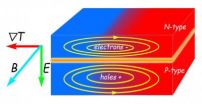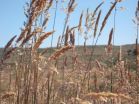(Press-News.org) Scientists at the U.S. Department of Energy's Lawrence Berkeley National Laboratory (Berkeley Lab) and their colleagues have discovered a new relation among electric and magnetic fields and differences in temperature, which may lead to more efficient thermoelectric devices that convert heat into electricity or electricity into heat.
"In the search for new sources of energy, thermopower – the ability to convert temperature differences directly into electricity without wasteful intervening steps – is tremendously promising," says Junqiao Wu of Berkeley Lab's Materials Sciences Division (MSD), who led the research team. Wu is also a professor of materials science and engineering at the University of California at Berkeley. "But the new effect we've discovered has been overlooked by the thermopower community, and can greatly affect the efficiency of thermopower and other devices."
Wu and his colleagues found that temperature gradients in semiconductors, when one side of the device is hotter than the opposite side, can produce electronic vortices – whirlpools of electric current – and can, at the same time, create magnetic fields at right angles to both the plane of the swirling electric currents and the direction of the heat gradient. The researchers report their results in Physical Review B.
Wu says, "There are four well-known effects that relate thermal, electric, and magnetic fields" – for example, the familiar Hall effect, which describes the voltage difference across an electric conductor in a perpendicular magnetic field – "but in all these effects the magnetic field is an input, not an outcome. We asked, 'Why not use the electric field and the heat gradient as inputs and try to generate a magnetic field?'"
To test the possibilities, the researchers modeled a practical device made of two layers of silicon: a thin, negatively doped layer (N-type) with an excess of electrons and a thicker, positively doped layer (P-type) with an excess of holes, which are electron absences that behave as positively charged particles.
At the junction where the oppositely doped silicon layers meet, a third kind of layer called a P-N junction forms, not physical but electronic: electrons from the N-type layer diffuse across the physical boundary into the P-type layer while holes move in the opposite direction, forming a depletion layer where charges are "dried out".
Given the high density of mobile electrons at the surface of the N-type layer and the high density of mobile holes at the surface of the P-type layer, but few mobile charges in the depletion layer, the electric field is strongest near the junction. This deep layer has profound effects, when a heat gradient is applied to the joined silicon layers.
Wake up and smell the champagne
"There are three ways charges can move – three kinds of currents," says Wu. "One is the diffusion current, in which particles move from denser areas to less dense areas. This has nothing to do with charge. Think of a bottle of champagne. I pop the cork, and a little while later you can smell the champagne, because the molecules diffuse from their dense concentration in the bottle into the air."
The second kind of current is called drift current. "If there's a draft in the room moving toward you, you may smell the champagne a little earlier, or if it's moving away from you, a little later," Wu explains. "In an electronic device, a drift current is caused by the voltage bias, the electric field."
Says Wu, "So in an electronic device we have diffusion current away from the dense charge areas, and drift current due to the electric field, and now we add a third, the thermoelectric current, which is another form of drift current in which charge carriers move from the hotter end of the device to the cooler end."
The results would be uninteresting if all the currents were pointing in the same direction, or in opposite directions, but they're not. The electric field sets up a drift current from the negatively charged top layer toward the positively charged bottom layer of the device – moving against the diffusion currents of the charge carriers. Meanwhile the heat gradient sets up a drift current at right angles to the electric field.
"In these conflicting perpendicular forces, electrons and holes cannot maintain straight motion but are sucked into vortices," Wu says.
Instead of a single vertical vortex in the device, vortices form in each layer and are separated by the depletion layer. In the N-type layer, the widely separated electrons near the depletion layer move with the temperature gradient, from hot to cold, but move in the opposite direction near the surface, where the electrons are bunched closer together. The vortex formed by holes in the N-type layer is nearly a mirror image of the electron vortex.
The unusual result is that merely by applying heat to one end of a simple silicon device, the researchers can generate a magnetic field perpendicular to the twin vortices – a magnetic field that emerges at right angles to the plane of the two silicon layers.
"The immediate application is not that we can make a magnetic field, which is relatively weak, but the realization that the efficiency of many semiconductor devices, including commercial products, could be made more efficient if we do it right," Wu says. "For example, designing them to make sure that their electric fields, and inhomogeneities in composition or doping, are aligned with their heat gradients would avoid these energy-wasting current vortices."
Wu's fascination with the new effect he and his teammates discovered doesn't stop there, however. "My interest isn't just in making more efficient electronics but in making good things out of this. The first step is to confirm with experiment what we've discovered through modeling. After that, a whole new program of research opens up."
Wu explains that the remarkable electronic and magnetic effects caused by temperature differences in the current model may well be duplicated by other kinds of inhomogeneous excitation – for example, by the way light falls on a solar cell. "Different intensities or different wavelengths falling in different areas of a photovoltaic device will produce the same kinds of electronic vortices and could affect solar cell efficiency. Understanding this effect may be a good path to better efficiency in electronics, thermal power, and solar energy as well."
INFORMATION:
"Electrothermally driven current vortices in inhomogeneous bipolar semiconductors," by Deyi Fu, Alejandro Levander, Rong Zhang, Joel Ager, and Junqiao Wu, appears in Physical Review B and is available online at http://prb.aps.org/abstract/PRB/v84/i4/e045205. Deyi Fu is with UC Berkeley and Nanjing University; Levander and Wu are with UC Berkeley and Berkeley Lab's MSD; Zhang is with Nanjing University, and Ager is with MSD. For further information, see Physical Review Focus at http://focus.aps.org/story/v28/st2. This work was partly supported by the National Science Foundation.
Lawrence Berkeley National Laboratory addresses the world's most urgent scientific challenges by advancing sustainable energy, protecting human health, creating new materials, and revealing the origin and fate of the universe. Founded in 1931, Berkeley Lab's scientific expertise has been recognized with 12 Nobel prizes. The University of California manages Berkeley Lab for the U.S. Department of Energy's Office of Science. For more, visit www.lbl.gov.
An unexpected clue to thermopower efficiency
Berkeley Lab scientists find that uneven temperature can lead to electronic whirlpools and sideways magnetic fields
2011-08-01
ELSE PRESS RELEASES FROM THIS DATE:
Boloco Earns Another 'Green' Star
2011-08-01
Back in March 2008 boloco, a chain of inspired burrito restaurants, became the first fast-casual chain in New England to become a Certified Green Restaurant by the Green Restaurant Association (GRA). But when boloco found out an even higher level of certification could be achieved - well, let's just say they reached for the stars. Boloco is now the first chain* of restaurants to become a 2 Star Certified Green Restaurant across all of their 17 locations.
For each of boloco's 17 locations to earn the GRA's rigorous two-star certification, they had to be inspected and ...
New study outlines economic and environmental benefits to reducing nitrogen pollution
2011-08-01
New, York, NY—July 28, 2011—A new study co-authored by Columbia Engineering professor Kartik Chandran and recently published in the journal, Environmental Science & Technology, shows that reducing nitrogen pollution generated by wastewater treatment plants can come with "sizable" economic benefits, as well as the expected benefits for the environment.
Chandran was one of five scientists from around the U.S. who worked on the study, along with James Wang of NOAA's Air Resources Laboratory and formerly of Environmental Defense Fund (EDF); Steve Hamburg, Chief Scientist ...
Genetic evidence clears Ben Franklin
2011-08-01
HOUSTON -- (July 28, 2011) -- The DNA evidence is in, and Ben Franklin didn't do it.
Genetic tests on more than 1,000 Chinese tallow trees from the United States and China show the famed U.S. statesman did not import the tallow trees that are overrunning thousands of acres of U.S. coastal prairie from Florida to East Texas.
"It's widely known that Franklin introduced tallow trees to the U.S. in the late 1700s," said Rice University biologist Evan Siemann, co-author the new study in this month's American Journal of Botany. "Franklin was living in London, and he had tallow ...
Scientists report dramatic carbon loss from massive Arctic wildfire
2011-08-01
In a study published in this week's issue of Nature, Marine Biological Laboratory (MBL) senior scientist Gauis Shaver and his colleagues, including lead author Michelle Mack of the University of Florida, describe the dramatic impacts of a massive Arctic wildfire on carbon releases to the atmosphere. The 2007 blaze on the North Slope of the Alaska's Brooks Mountain Range released 20 times more carbon to the atmosphere than what is annually lost from undisturbed tundra.
As wildfires increase in frequency and size along Alaska's North Slope, the team contends the disturbances ...
WSO2 Presents Workshops on Enterprise Integration and Security in the Cloud
2011-08-01
Enterprise IT architects and developers face the dual demands of optimizing their service-oriented architecture (SOA) implementations on-premise while also seeking ways to leverage the cloud. This month, WSO2 (http://wso2.com?080111w) delivers technical workshops designed to address two of enterprises' top SOA challenges: enterprise integration and security in the cloud.
Security in the Cloud: August 4, 2011, Palo Alto, CA
The WSO2 "Security in the Cloud" workshop will identify the security challenges that can stop or slow a move to the cloud, review open ...
Breakthrough lights way for RNA discoveries
2011-08-01
NEW YORK (July 28, 2011) -- The ability to tag proteins with a green fluorescent light to watch how they behave inside cells so revolutionized the understanding of protein biology that it earned the scientific teams who developed the technique Nobel Prizes in 2008. Now, researchers at Weill Cornell Medical College have developed a similar fluorescent tool that can track the mysterious workings of the various forms of cellular RNA.
In the July 29 issue of Science, the Weill Cornell investigators report how they developed an RNA mimic of green fluorescent protein (GFP) ...
Mannan oligosaccharides offer health benefits to pigs
2011-08-01
Feeding mannan oligosaccharides (MOS) can fine-tune the immune system of pigs, suggests a new University of Illinois study.
"When it comes to keeping pigs healthy, there are some potentially powerful tools we can use in the diet besides antibiotics," said James Pettigrew, U of I professor of animal science. "We have a tendency to think that we can administer health through a needle, by giving pigs antibiotics, and even through systems like all-in/all-out pig flow. These are important, but there are also many health benefits we can realize through the diet."
MOS is a ...
More illness, doctor visits reported in years after Sept. 11, UCI study finds
2011-08-01
Irvine, Calif., July 28, 2011 — The events of Sept. 11, 2001, changed the way Americans travel and view the world. They may also have made us sicker and more likely to access healthcare services, according to a new UC Irvine study.
In the first three years after the terrorist attacks, researchers found, reports of doctor-diagnosed illness climbed by 18 percent in a nationally representative sample of adults. The jump was highest in those with pre-existing health conditions, but people who were healthy before 9/11 also experienced an increase in physician-diagnosed ailments. ...
Warming climate could give exotic grasses edge over natives
2011-08-01
California's native grasses, already under pressure from invasive exotic grasses, are likely to be pushed aside even more as the climate warms, according to a new analysis from the University of California, Berkeley.
In the study, which has been accepted for publication in the journal Global Change Biology and is now available online, UC Berkeley biologists catalogued the ranges of all 258 native grasses and 177 exotic grasses in the state and estimated how climate change – in particular, increased temperature and decreased rainfall – would change them.
They concluded ...
Caltech researchers increase the potency of HIV-battling proteins
2011-08-01
PASADENA, Calif.—If one is good, two can sometimes be better. Researchers at the California Institute of Technology (Caltech) have certainly found this to be the case when it comes to a small HIV-fighting protein.
The protein, called cyanovirin-N (CV-N), is produced by a type of blue-green algae and has gained attention for its ability to ward off several diseases caused by viruses, including HIV and influenza. Now Caltech researchers have found that a relatively simple engineering technique can boost the protein's battling prowess.
"By linking two cyanovirins, we were ...
LAST 30 PRESS RELEASES:
Journal of Nuclear Medicine Technology supplement highlights advances in theranostics and opportunities for growth
New paper rocks earthquake science with a clever computational trick
ASH 2025: Milder chemo works for rare, aggressive lymphoma
Olfaction written in bones: New insights into the evolution of the sense of smell in mammals
Engineering simulations rewrite the timeline of the evolution of hearing in mammals
New research links health impacts related to 'forever chemicals' to billions in economic losses
Unified EEG imaging improves mapping for epilepsy surgery
$80 million in donations propels UCI MIND toward world-class center focused on dementia
Illinois research uncovers harvest and nutrient strategies to boost bioenergy profits
How did Bronze Age plague spread? A sheep might solve the mystery
Mental health professionals urged to do their own evaluations of AI-based tools
Insufficient sleep associated with decreased life expectancy
Intellicule receives NIH grant to develop biomolecular modeling software
Mount Sinai study finds childhood leukemia aggressiveness depends on timing of genetic mutation
RSS Research Award for new lidar technology for cloud research
Novel AI technique able to distinguish between progressive brain tumours and radiation necrosis, York University study finds
Why are abstinent smokers more sensitive to pain?
Alexander Khalessi, MD, MBA, appointed Chief Innovation Officer
Optical chip pioneers physical-layer public-key encryption with partial coherence
How your brain understands language may be more like AI than we ever imagined
Missed signals: Virginia’s septic strategies overlook critical timing, study warns
Delayed toxicities after CAR T cell therapy for multiple myeloma are connected and potentially preventable
Scientists find cellular key to helping plants survive in saltwater
Medical cannabis program reduces opioid use
Immunotherapy works for sepsis thanks to smart patient selection
Cardiovascular events 1 year after RSV infection in adults
US medical prices and health insurance premiums, 1999-2024
Medical cannabis and opioid receipt among adults with chronic pain
Multichannel 3D-printed bioactive scaffold combined with siRNA delivery for spinal cord injury recovery
Triaptosis—an emerging paradigm in cancer therapeutics
[Press-News.org] An unexpected clue to thermopower efficiencyBerkeley Lab scientists find that uneven temperature can lead to electronic whirlpools and sideways magnetic fields




